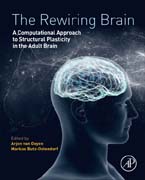
The Rewiring Brain: A Computational Approach to Structural Plasticity in the Adult Brain
Van Ooyen, Arjen
Butz-Ostendorf, Markus
The adult brain is not as hard-wired as traditionally thought. By modifying their small- or large-scale morphology, neurons can make new synaptic connections or break existing ones (structural plasticity). Structural changes accompany memory formation and learning, and are induced by neurogenesis, neurodegeneration and brain injury such as stroke. Exploring the role of structural plasticity in the brain can be greatly assisted by mathematical and computational models, as they enable us to bridge the gap between system-level dynamics and lower level cellular and molecular processes. However, most traditional neural network models have fixed neuronal morphologies and a static connectivity pattern, with plasticity merely arising from changes in the strength of existing synapses (synaptic plasticity). In The Rewiring Brain, the editors bring together for the first time contemporary modeling studies that investigate the implications of structural plasticity for brain function and pathology. Starting with an experimental background on structural plasticity in the adult brain, the book covers computational studies on homeostatic structural plasticity, the impact of structural plasticity on cognition and cortical connectivity, the interaction between synaptic and structural plasticity, neurogenesis-related structural plasticity, and structural plasticity in neurological disorders. Structural plasticity adds a whole new dimension to brain plasticity, and The Rewiring Brain shows how computational approaches may help to gain a better understanding of the full adaptive potential of the adult brain. The book is written for both computational and experimental neuroscientists. Reviews the current state of knowledge of structural plasticity in the adult brain Gives a comprehensive overview of computational studies on structural plasticity Provides insights into the potential driving forces of structural plasticity and the functional implications of structural plasticity for learning and memory Serves as inspiration for developing novel treatment strategies for stimulating functional repair after brain damage INDICE: Section 1. Experimental Background 1. Structural plasticity and cortical connectivity2. Structural plasticity induced by adult neurogenesis3. Structural neural plasticity during stroke recovery4. Is lesion-induced synaptic rewiring driven by activity homeostasis? Section 2. Homeostatic Structural Plasticity5. Network formation through activity-dependent neurite outgrowth: a review of a simple model of homeostatic structural plasticity6. Clustered arrangement of inhibitory neurons can lead to oscillatory dynamics in a model of activity-dependent structural plasticity 7. A detailed model of homeostatic structural plasticity based on dendritic spine and axonal bouton dynamics8. Critical periods emerge from homeostatic structural plasticity in a full-scale model of the developing cortical column9. Lesion-induced dendritic remodeling as a new mechanism of homeostatic structural plasticity in the adult brainSection 3. Structural Plasticity and Connectivity10. The role of structural plasticity in producing nonrandom neural connectivity11. Structural plasticity and the generation of bidirectional connectivity12. Spike-timing dependent structural plasticity of multi-contact synaptic connections13. Selection of synaptic connections by wiring plasticity for robust learning by synaptic weight plasticitySection 4. Structural Plasticity and Learning and Memory14. Within a spine's reach15. Impact of structural plasticity on memory capacity16. Long-term information storage by the interaction of synaptic and structural plasticity17. Impact of structural plasticity on memory formation and declineSection 5. Neurogenesis-Related Structural Plasticity18. Adult neurogenesis and synaptic rewiring in the hippocampal dentate gyrus19. Modifications in network structure and excitability may drive differential activity dependent integration of granule cells into Dentate Gyrus circuits during normal and pathological adult neurogenesis20. Computational perspectives on adult neurogenesis21. Restricted Boltzmann Machine models of hippocampal coding and neurogenesisSection 6. Structural Plasticity and Pathology22. Modeling the impact of lesions in the brain23. Network models of epilepsy-related pathological structural and functional alterations in the dentate gyrus24. Computational models of stroke recovery25. Neural plasticity in human brain connectivity: the effects of deep brain stimulation
- ISBN: 978-0-12-803784-3
- Editorial: Academic Press
- Encuadernacion: Cartoné
- Páginas: 450
- Fecha Publicación: 01/06/2017
- Nº Volúmenes: 1
- Idioma: Inglés
